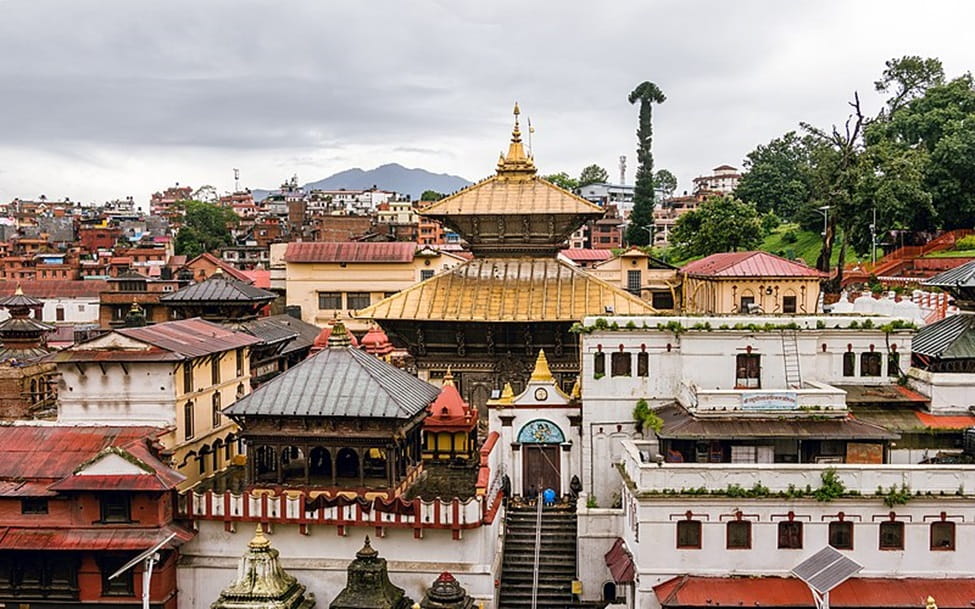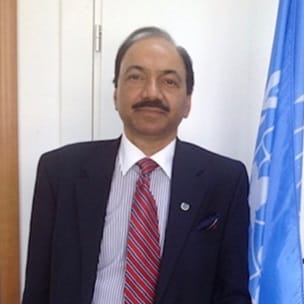
Pashupatinath Temple, Kathmandu

Historical and Cultural Connection
India and Nepal share very close historical and cultural relations, which has been the bedrock of their ties. As mentioned in the ancient Indian epic, Ramayana, Lord Rama of Ayodhya was married to Goddess Sita of Janakpur. Kirats were an important part of the Pandav Army in the battle of Kurukshetra in Mahabharata. During 6th Century BC, Magadh and Shakya Republics occupied territories on both sides of the current Indo-Nepal border. Prince Siddhartha was born in 566 BC in Lumbini near Kapilvastu, the capital of Shakya rulers which is now in Nepal. He attained Nirvana in Sarnath near Varanasi, a city whose connection with Nepal is as old as history. Some of the rarest texts of Skandpurana are preserved in Nepal, palm leaf manuscripts dated AD 810 that are available in Kathmandu. Kashi has been the centre for Nepali pilgrims, priests and at one time, even the exiles. When King Rajendra was asked to choose the destination for his exile, he chose Varanasi in 1846.
K.P. Bhattarai was born in Varanasi. He joined the Indian independence movement against the British Raj in India and the Rana rule in Nepal. Banaras was also one of the main venues where the anti-Rana movement started. The Colony DugdhVinayak continues to be known as Nepali Colony and the language spoken in this Colony is Nepali.
Banaras Hindu University (BHU) was the main centre for Nepali students and intellectuals. Krishna Prasad Koirala with more than 40 members of his family lived in Banaras in 1917. They launched publications “Gorkhali” and “Janmbhoomi” which highlighted atrocities and injustices of the Rana regime. The Koiralas also joined the Non-Cooperation Movement and had a formal membership of the Indian National Congress. In 1947, the Nepal National Congress decided to establish its head office in Banaras while K.P. Bhattarai was heading the office. On the other hand, the Communist Party of Nepal was founded in Calcutta by Pushp Lal Shreshtha in 1950. All India Gorkha League was formed in 1921 in Dehradun.
Since 1815, after the Treaty of Sugauli, Nepalis have been recruited in the British Indian / Indian Army. The pension ($615 million) to ex-Gurkha regiment personnel is more than the annual budget of Nepal ($450 million). Even in present times, Prachanda lived in India during most part of his Maoist Movement.
India and Nepal have a special relationship by way of Treaty of Peace and Friendship (1950) which laid down the foundation for Nepalis to enjoy national rights in India making them eligible to serve in Indian Government and security forces.The two Armies also have a tradition of awarding the honorary rank of General to each other’s Army Chiefs.
Socially, culturally and by way of religion, there are many commonalities between India and Nepal. There is also close cooperation between India and Nepal in other fields including defence, police, intellectual development, security issues, water sharing, academic exchanges, student admissions etc. Because of the open border between India and Nepal, the people-to-people relations among the citizens of the countries have remained unparalleled.
Developmental Assistance
Despite its own pressing requirements, India has assisted Nepal since the time it became independent in 1947. This has been in sync with India’s desire to support its neighbours and the South-South cooperation philosophy followed by Indian leadership. Some of the major projects implemented have been :
.The first highway linking the Kathmandu valley with the plains (1953);
.Nepal’s first six airports at Gauchar (1951), Simra (1964), Janakpur (1964), Bhairahawa (1964) Pokhara (1964) and Biratnagar (1968);
.Koshi Barrage (1963), Devighat Hydropower and Irrigation Project (1983);
.Bir Hospital in Kathmandu (1984), Institute of Forestry (1950), the railways at Janakpur (1996);
.Most parts of the East-West Highway (1966) and key sections of the Tribhuvan University, one of the first centres for higher education in the country (1960);
.B.P.Koirala Institute of Earth Science, Optical Fibre Cable Project, Lumbini Museum 2004, Kathmandu airport, Bagmati bridge in Mathmandu, Janakpur, Birganj and Raxaul railway.
.There are a number of other initiatives underway to further strengthen the relationship. However, there is scope for further cooperation in various fields.
Way Ahead and Recommendations
New Delhi and Kathmandu could establish a joint high-level Commission on Common Himalayan Environment and Bio-diversity, keeping in mind the common challenges posed by climate change.
The following recommendations would help to further cement India-Nepal ties, especially cultural, connectivity and people to people aspects.
1. There should be tie ups between Indian Agricultural Research Institute (IARI) and similar institutions in Nepal. India could also establish an Agriculture University in Nepal with the help of Indian universities, for example Pant Nagar Agriculture University. India’s Dairy Development Board may facilitate transfer of milk technology to Nepal on the pattern of Amul.
2. India can look at the possibility of extending IT services/optical fibre and establishing IT back offices in Nepal.
3. There is ample scope to hold trade fairs in Nepal/India that would increase awareness about mutual business opportunities among small and medium traders.
4. India can also assist Nepal in improving its cricket infrastructure, coaching and training methods.
5. Nearly six million Nepalis live and work in India, some of whom have done extremely well. They need to be brought on common India-Nepal friendship platforms to further strengthen people to people contacts.
6. A platform for promoting religious links between Hindus and Buddhists of the two countries needs to be established. Religious leaders like Sri Sri Ravishankar, Baba Ramdev, Brahma Kumaris are active in this field.
7. Centres may also be established in Indian/Nepali universities/colleges/schools for research/study of common languages including Hindi, Maithili, Bhojpuri/Nepali etc.
8. Number of Nepali students studying in India can remain in touch with their alma mater through their alumni associations. Tie ups could be established between the Banaras Hindu University, University of Allahabad, University of Patna, University of Lucknow, University of Calcutta, JNU (traditionally Nepalis come to these places) etc. and universities in Nepal to enhance cooperation between higher educational and professional institutions. A quota may also be fixed for Nepali students in these Universities. There is no authentic study of common history, culture between the two countries. These tie-ups can further encourage research in common religious traditions and ethnology.
9. India has extended support to Nepal during natural calamities and disasters. India’s expertise in Disaster Management can be used to train Nepali staff and for creating institutions like National Disaster Management Authority (NDMA).
10. India’s considerable expertise in cyber security can be shared with Nepal to make sure they are not subject to cyber threat/banking frauds as in the recent past.
11. Both India and Nepal have a wealth of herbs grown in Himalayan region. Further research could be undertaken for medicinal properties of these herbs.
12. While tremendous progress has been made in establishing hydroelectricity power plants in Nepal in collaboration with India, research on transborder environmental issues like flood, glacial melt, earthquake, landslides etc for preventing damage to soil and ecosystem can be jointly undertaken by both countries. Existing flood forecasting and disaster early warning systems need to be established for effective public dissemination.
13. In April 2018, an understanding between Indian and Nepal’s Prime Ministers was reached for river navigation. This needs to be followed up.
14. Early completion of all pending projects like Pancheshwar Project, Koshi, Sharda Barrage, Gandhak Barrage Arun-III and Upper Karnali Project etc. has been already undertaken by both governments.
15. India can launch a Satellite for Nepal’s exclusive use like weather/education.
16. Both Varanasi and Kathmandu have already been declared sister cities as also Sarnath/Lumbini. Joint cultural programs, business projects, preference in educational institutions and scholarships to students belonging to sister cities may be considered.
17. An air service between Ayodhya-Janakpur-Kathmandu will also further promote tourism. Nepal has a number of tourist spots; however, more information needs to be disseminated to Indian tourists about those places. Tourist information and promotion centres in various parts of Nepal and India need to be established.
18. Development of special corridors like Lumbini-Bodhgaya, Sarnath-Kushinagar, Pashupatinath-Kashivishwanath, Ramayana circuit (Janakpur-Ayodhya), Runtek-Thangboche, Muktinath-Tirupathi etc. are under consideration and need to be developed.
Conclusion
The geographical contiguity, historical cultural links and socioeconomic opportunities that connect India and Nepal have created a natural partnership that should be nurtured with mutual understanding, trust and sensitivity, for furthering prosperity and security for both countries. There are ample opportunities for both sides to further deepen their ties and the future holds an optimistic outlook.
(Exclusive to NatStrat)